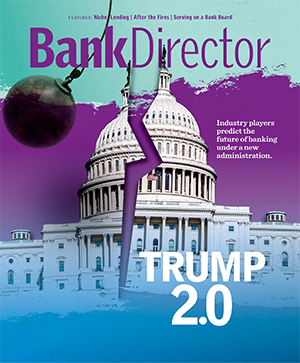Laura Alix is the Director of Research at Bank Director, where she collaborates on strategic research for bank directors and senior executives, including Bank Director’s annual surveys. She also writes for BankDirector.com and edits online video content. Laura is particularly interested in workforce management and retention strategies, environmental, social and governance issues, and fraud. She has previously covered national and regional banks for American Banker and community banks and credit unions for Banker & Tradesman. Based in Boston, she has a bachelor’s degree from the University of Connecticut and a master’s degree from CUNY Brooklyn College.

Market Volatility Disrupts Banks’ Capital Plans
Economic uncertainty has clouded the outlook for banks’ growth, IPO and M&A activity this year.
Market volatility and an uncertain economic outlook have cast a pall over banks’ growth plans for 2025, at least when those plans require additional capital.
For much of the industry, the year began on a largely optimistic note. Bank stocks rebounded following the election of Donald Trump to a second presidential term, due to an anticipated comeback in M&A, a reduced regulatory burden and a stronger economy to drive more growth. But the imposition of broad-based tariffs, along with murmurings in April that the president would try to fire Federal Reserve Chair Jerome Powell, introduced new turbulence into the market.
Bankers that planned to raise capital for one reason or another now face a different set of circumstances than they did at the beginning of the year. By late April, bank stocks had given back all of their post-election gains and then some: The KBW Nasdaq Regional Banking Index jumped 13% to $133.26 the day after the election. By April 29, it had lost those gains, declining to $107.56.
“Practically for anybody, it’s a challenging time to be raising capital,” says Christopher Olsen, managing partner with the investment banking firm Olsen Palmer. “There’s not a lot of interest from issuers to issue capital in general, because either they already have it or more practically, their stock prices are way down and now is a bad time to be doing it.” Investor enthusiasm has subsided, for one thing. For another, banks’ optimism had been buoyed partially by the prospect of cuts to the federal funds rate, a scenario that looks less likely as tariffs are expected to be inflationary.
Mark Kanaly, a partner at Alston & Bird, says he sees targeted interest in capital raising for acquisitions and balance sheet restructuring. What’s absent right now are efforts to raise capital for organic growth.
Banks are also reexamining credit quality and stress testing results in order to think through the potential impacts of an uncertain economy on their business, says Kevin Brand, a partner with Crowe. They’re connecting capital needs to their strategy and whether to adjust those plans before raising capital. “As things have changed, and the markets shifted, [banks are] revisiting that and asking, ‘Where do I stand now? What are the impacts over the next three, six or 12 months? And what are my best avenues for long-term growth?’” he says. Banks are also refining their rationale for raising capital. “If you’re in a great market and growing, that’s a better story for needing capital than just trying to shore up potential losses.”
By and large, banks are not raising capital to weather problem loans right now.
“The good news is, most banks have a lot of capital,” says Dory Wiley, CEO of Commerce Street Holdings. “But if they want to grow, they’re going to need some more.” He still sees guarded optimism on M&A, but initial public offerings “are gone in every sector right now.”
Kanaly says there’s still an appetite to access the public markets. Some banks are working behind the scenes to prepare for initial public offerings, preparing filings and testing the waters in the hope that they can be among the first entrants when IPO prospects improve. However, “those IPOs probably won’t be executable until there’s certainty and lack of volatility,” he says.
Wiley predicts IPO activity will need to rebound in other sectors before it reaches the banking industry. Investors tend to disfavor bank stocks compared with other sectors. They also tend to sell their holdings of smaller banks before they sell off large, money center bank stocks, a phenomenon Wiley characterizes as not necessarily fair or logical.
After all, the banking industry is still fundamentally strong. Credit quality metrics remain solid, and banks are generally well-capitalized and reserved against loan losses.
Olsen anticipates the market may achieve some measure of stability once it gets clarity on tariffs, and what they could mean for banks’ customers and communities. “I think generally, the world will know a lot more about that in the next 90 days,” Olsen says.
Banks, and publicly traded banks in particular, would benefit from one to two quarters of relative calm and stability in the stock market, characterized by a lack of market-shaking news, Kanaly says. “It’s always hard to anticipate what the market’s bringing you next, but where there’s this much uncertainty and volatility, it’s just not conducive to doing anything.”


